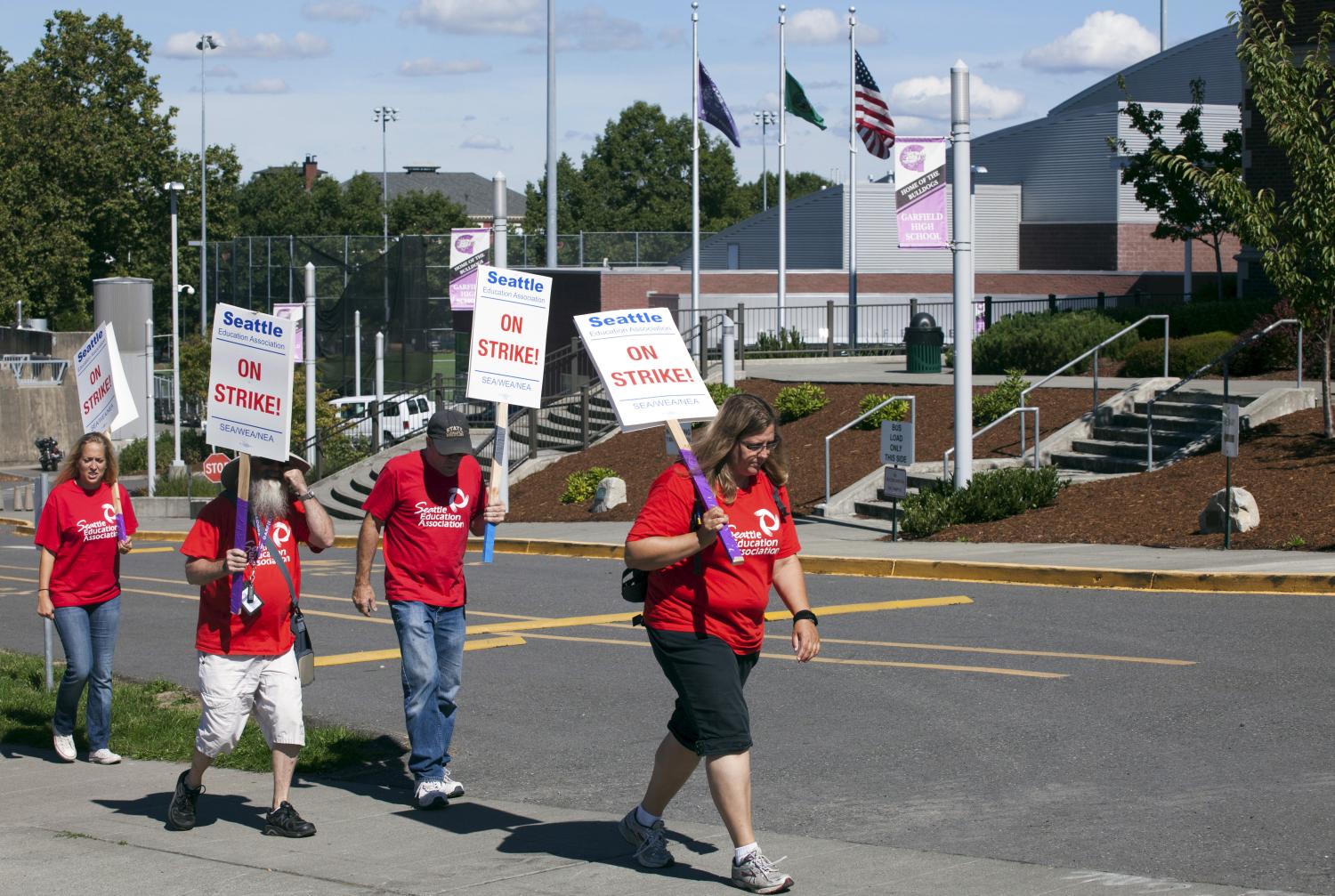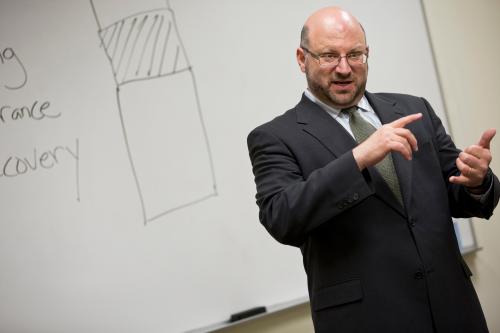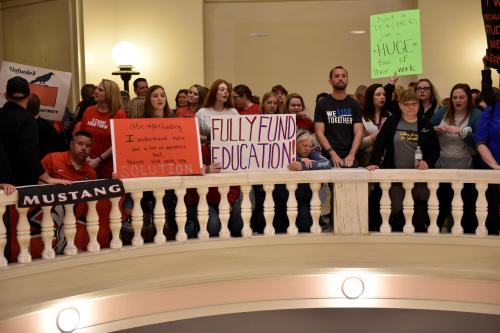As the new school year kicks off, of the many newsworthy education stories that continue to unfold, one of the most compelling is how teacher protests and strikes continue to develop across the U.S.
This story began with a nine-day strike in West Virginia this February and eventually boiled over last spring to strikes and protests over pay, pensions, and education spending across a number of states, including Arizona, Kentucky, and Colorado. The advent of summer break lowered the heat to a simmer in states like North Carolina and Oklahoma, where some concessions were made, but left some teachers still agitating for more.
With interest, I followed these teacher strikes as they developed, and wrote about several of the factors that appear to be common across states that saw statewide actions. One factor, I argued, was the decline in real teacher salaries (i.e., after inflation) that teachers in many states have seen since the onset of the Great Recession. A counterargument that I heard in the wake of that writing, however, posits that no small part of the decline in average teacher salaries is a mechanical result of retiring and well-paid baby boomers being replaced by new entry-level millennials.
In other words, our workforce is simply becoming less qualified and their salaries are adjusting accordingly, owing to the heavy reliance on salary schedules where teaching experience and graduate degrees primarily determine teachers’ pay.
I was initially skeptical of this claim, mostly based on the magnitude of the decline in salaries. Many states have seen salary reductions averaging 4.6 percent since the 2009-10 school year, according to the Digest of Education Statistics put out by the U.S. Department of Education. These declines simply seemed too large to be caused by a slow wave of retirees alone. Further, many states imposed salary freezes or revamped compensation schedules in efforts to squeeze their budgets as far as possible in the wake of the recession; these have been documented several times over before the strikes even broke out. These freezes had to amount to something.
Yet, at the urging of a colleague, I decided to check the data rather than go with my gut. What I found not only confirmed my suspicion that retirees are not the source of the declines, but also suggested that we are now paying teachers even less generously than I had believed. Let me explain what I did and what this means about our teaching workforce.
I started by gathering data from the American Community Survey (ACS), an annual survey administered by the U.S. Census Bureau to households across the country. I zeroed in on respondents whose occupation was listed as a full-time public school teacher, paying attention to their reported total salary from their main job. I looked at survey samples taken at two different points in time—one in 2007 just before the recession, and one with the most recent data in 2016.
It is important to note that this is a different data source than what is reported in the Digest of Education Statistics mentioned above. The average compensation figures are a couple thousand dollars smaller in the ACS—it appears that the ACS definition of salary excludes supplemental pay or bonuses teachers might earn separately from salary. For this analysis, this should be fine, as the ACS data should therefore represent a more precise view of pay based on formal salary schedules. Also, I chose to look at 2007 as my pre-recession year (rather than the 2009-10 data reported above) as it reduces the possibility of including early recession-induced cuts in the analysis.
Based on this new data, I see a slightly smaller 2.2 percent decline in salaries than what the Digest of Education Statistics reports (4.6 percent). Though these numbers do differ slightly, I’m using the more detailed data from the ACS to hone in on how teachers’ compensation schedules evolved over this period.[1]
To answer the retiring teacher hypothesis, I conducted an Oaxaca-Blinder decomposition.[2] This is an econometric technique that parcels out the observed declines in salary to that based on observable differences in workforce characteristics (e.g., average teacher age falling) and that based on other reductions in how we pay teachers that are not accounted for in the model (e.g., salary freezes). Here is what this analysis yielded.
Surprisingly, if we consider teacher characteristics alone, we should actually have expected teacher salaries to rise—not fall—over the period of the Great Recession. In other words, teachers are even more qualified after the recession, based on these metrics. For example, I found the average teacher age is about three months older in 2016 than what was reported in 2007. Perhaps the Great Recession made baby boomers nervous about retiring, or maybe tight budgets have slowed the replacement by millennials. Beyond age, teachers in the data report having significantly higher levels of master’s (54 percent) and doctoral degrees (4.5 percent) than what they did in 2007 (49 percent and 2.5 percent, respectively). Combined, these characteristics suggest we should actually be paying teachers about 1 percent more after the recession if we didn’t change compensation in other ways.
This means teachers’ pay has actually gone down more than I believed. Previously, I saw a 2.2 percent reduction in inflation-adjusted pay and believed that was the end of it. Yet, if we account for the fact that qualifications have actually increased, this means the net effect of our budget cuts combined to create a decline of 3.5 percent, more than 50 percent larger than I believed. Think of this as a math problem:
This decomposition method does not parse out cause and effect. It is very possible that teachers are garnering higher qualifications precisely so the declines in how we pay them don’t sting as much. Getting an advanced degree or staying in the classroom longer could thus be a means to secure a higher wage for their work (though this could be counterproductive if teachers have to pay a lot for tuition or forego pension benefits). Thus, we can view these increases in qualifications in a similar light as the increase in moonlighting teachers during the recession years, particularly in low-paying states.
Keep in mind these national trends are not necessarily true of every state—as each has its own way of paying teachers and a unique workforce. I replicated this decomposition technique in each state of the six states that saw teacher actions during the spring (Arizona, Colorado, Kentucky, North Carolina, Oklahoma, & West Virginia), and West Virginia was the only state in which the retiring teacher hypothesis may have some bearing. The average teacher age there declined by nearly 3 years between 2007 and 2016, accounting for nearly all of the observed drop in pay. Salary declines in all other states, though, could not be substantively accounted for by changes in age or other characteristics.
This evidence should compel the public and policymakers to rethink our popular assumptions about how generously (or not) teachers are paid. We all know teaching is not a lucrative profession, but this popular understanding overlooks differences in how teachers’ salaries have eroded over time. Coupling these results with other ways teachers’ take-home paychecks shrunk during the recession paints a picture of a modestly paid profession slowly growing less financially viable over time for many young people. This diminishing pay explains why hard-to-fill vacancies persist in most states and teaching is—unfortunately—increasingly perceived as a career to avoid.
As students now return to school, teacher actions—whether formally organized or not—are picking up once again. Interestingly, many of these reports are coming from states that did not see major actions earlier this year, including district-level actions in Washington state, California, and a teacher-led hunger strike in Georgia. The persistent vacancies should give teachers leverage, and public opinion also appears to be favoring teachers. Yet, the Janus v. AFSCME Supreme Court decision over the summer is a new change in the bargaining environment between teachers and school districts, which may inhibit some collective actions from achieving the scale we saw last spring.
It is unclear how these teacher actions will continue to evolve in the coming school year. Regardless, I’ll be watching closely.
Francesca Royal contributed to this post.
Footnotes
- When computing state-level changes in average salary and comparing these figures across data sets, I find a correlation coefficient of 0.54. Larger observed declines in the Digest of Education Statistics is what we might reasonably expect if bonuses or supplemental pay were more likely than compensation schedules to be curtailed in the wake of the recession. Thus, it’s reasonable that these are conservative estimates of the overall decline in teacher compensation during this period. (Back to top)
- The regression model included teachers’ age, postgraduate education level, and indicator variables controlling for locale (e.g., suburban, town/rural) as observable characteristics that determine salaries. (Back to top)
The Brookings Institution is committed to quality, independence, and impact.
We are supported by a diverse array of funders. In line with our values and policies, each Brookings publication represents the sole views of its author(s).









